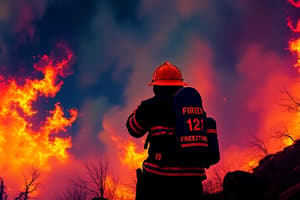Podcast
Questions and Answers
What is the overall purpose of the lesson on search and rescue operations?
What is the overall purpose of the lesson on search and rescue operations?
To carry out search and rescue operations as safely and efficiently as possible.
What are the three major steps by firefighters that assist them in carrying out rescue missions?
What are the three major steps by firefighters that assist them in carrying out rescue missions?
Conditioning, protective gear, SCBA.
Which of the following conditions can cause injury to firefighters during operations? (Select all that apply)
Which of the following conditions can cause injury to firefighters during operations? (Select all that apply)
- Lack of additional firefighters (correct)
- Poor physical condition (correct)
- High levels of anxiety and exertion (correct)
- Properly maintained gear
The victim of a fire typically has access to protective gear.
The victim of a fire typically has access to protective gear.
The very young lack sufficient understanding of the dangers, making them ____ in a fire situation.
The very young lack sufficient understanding of the dangers, making them ____ in a fire situation.
Who is considered to be in a high-risk group during a fire situation? (Select all that apply)
Who is considered to be in a high-risk group during a fire situation? (Select all that apply)
What impact does a firefighter's injury have on their family?
What impact does a firefighter's injury have on their family?
Flashcards are hidden until you start studying
Study Notes
### Search and Rescue Operations
- The overall purpose of Search and Rescue Operations is to execute them safely and efficiently, given the tactical situation.
- The main objectives of the lesson include understanding the major factors impacting the rescuer, the victim, the search and rescue environment, and the strategic and tactical considerations to achieve search and rescue mission objectives.
The Rescuer
- When a firefighter is injured during operations, three additional firefighters are typically required to assist them.
- Firefighters are susceptible to anxiety and exertion during operations, particularly during search and rescue missions.
Steps to Prevent Injury
- Well-conditioned firefighters are less prone to injury.
- Properly worn and maintained protective gear and SCBA can prevent injury.
- Proper training is crucial for using SCBA effectively.
The Victim
- Victims may be in poorer physical condition than rescuers, lacking protective gear and SCBA.
- The victim is at risk from heat, smoke, and other conditions during a fire.
- Rescuers must consider the victim's emotional state and level of consciousness.
- An alert victim can assist in their rescue, while an unconscious victim poses a higher risk.
High-Risk Groups
- The very young: Lack the understanding of danger and may not be physically or mentally developed to escape danger.
- The very old: May not understand the situation or have the physical ability to escape.
- The ill: May be unaware of their surroundings, confined to a bed or chair for their own safety, and unable to move independently.
- Large groups of people in a public assembly: As group size increases, the likelihood of panic rises significantly.
- They rarely check emergency exits and often try to leave the same way they entered.
- In panic, they may react irrationally and enter danger to retrieve belongings.
- One person's cry of panic can lead to a stampede.
Studying That Suits You
Use AI to generate personalized quizzes and flashcards to suit your learning preferences.




